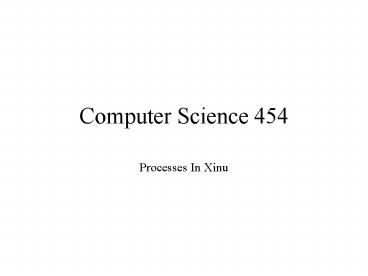Computer Science 454 PowerPoint PPT Presentation
Title: Computer Science 454
1
Computer Science 454
- Processes In Xinu
2
Process vs. Program
- process
- dynamic
- part of a program in execution.
- a live entity, it can be created, executed, and
terminated. - it goes trough different states
- wait
- running
- ready, etc.
- Requires resources to be allocates by the OS.
- zero or more processes may executing the same
code. - program
- static
- no states
3
Process creation, system calls and Context
Switching
- getpid() /gets the current pid/
- getppid() /gets the parent pid/
- exec, execl, execv /See the man page!/
- execl(/bin/ls, ls, -l, (char 0))
/overlay original program - use fork then exec() - how shell commands work
- orphaned/zombie processes (later)
- XINU implements fork() as create() -(see man fork)
- Context Switch
- Saves current machine state
- loads the next scheduled process
- via interrupt, multiprogramming, etc.
4
Parent child processes
- main()
- int pid /hold process-id in parent/
- printf(Just one process so far\n)
- printf(Calling fork \n)
- pid fork() / create new process /
- if ( pid 0 )
- printf( I am the child\n)
- else if ( pid gt 0 )
- printf( Im the parent, the child has pid
d\n, pid) - else
- printf( fork returned error code, no
child\n)
5
fork() example
6
List and Queue manipulation
- Important Constants
- NSEM of semaphores
- NQENT of entries in q array (see q.h on page
58) - NPROC Max of processes a system can have.
- List and Queue Processing
- Doubly linked lists
- head
- tail
- node
- prevPtr
- data
- nextPtr
7
Queue Structure
Highest priority items at link next to tail.
(see page 62 in text) This is an array
implementation of a doubly linked list enqueue,
dequeue (see page 60 in text)
8
Implementation of Queue Array
- Used to keep track of
- Ready List
- 2 entries
- List for each Semaphore
- 2NSEM
- Sleep List
- 2 entries
- See page 57 in text
- 42NSEM NPROC NQENT
PowerShow.com is a leading presentation sharing website. It has millions of presentations already uploaded and available with 1,000s more being uploaded by its users every day. Whatever your area of interest, here you’ll be able to find and view presentations you’ll love and possibly download. And, best of all, it is completely free and easy to use.
You might even have a presentation you’d like to share with others. If so, just upload it to PowerShow.com. We’ll convert it to an HTML5 slideshow that includes all the media types you’ve already added: audio, video, music, pictures, animations and transition effects. Then you can share it with your target audience as well as PowerShow.com’s millions of monthly visitors. And, again, it’s all free.
About the Developers
PowerShow.com is brought to you by CrystalGraphics, the award-winning developer and market-leading publisher of rich-media enhancement products for presentations. Our product offerings include millions of PowerPoint templates, diagrams, animated 3D characters and more.

